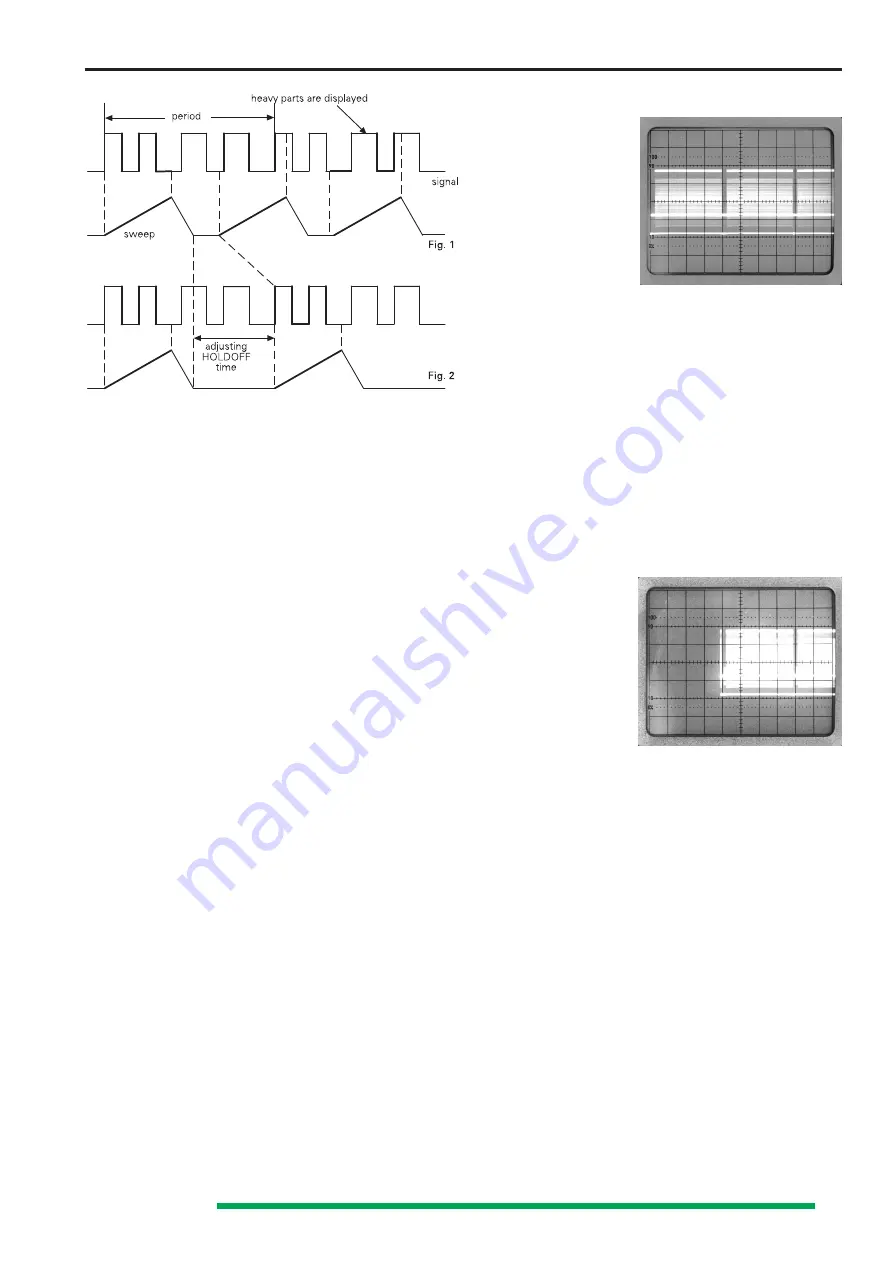
17
Subject to change without notice
Fig. 1 shows a case where the HOLD OFF knob is in the
minimum position (x1) and various different waveforms are
overlapped on the screen, making the signal observation
unsuccessful.
Fig. 2 shows a case where only the desired parts of the signal
are stably displayed.
Delay / After Delay Triggering
As mentioned before, triggering starts the time base sweep
and unblanks the beam. After the maximum X deflection to
the right, the beam is blanked and flies back to the (left) start
position. After the hold off period the sweep is started
automatically by the automatic trigger or the next trigger
signal. In normal triggering mode the automatic trigger is
switched off and will only start on receipt of a trigger signal.
As the trigger point is always at the trace start position, trace
expansion in X direction with the aid of the timebase is limited
to the display on the left of the trace. Parts of the signal to
be expanded which are displayed near the trace end (right
side of the screen) are lost when the timebase speed is
increased (time coefficient reduced).
The delay function delays the trace start by a variable time
from the trigger point. This allows the sweep to begin on
any portion of a signal. The timebase speed can then be
increased to expand the display in X direction. With higher
expansion rates, the intensity reduces and within certain limits
this can be compensated by the
INTENS
knob setting.
If the display shows jitter, it is possible to select for (second)
triggering after the elapsed delay time (DTR).
As mentioned before, it is possible to display video signals
using the frame sync pulses for triggering (TV-F). After the
delay time set by the operator, the next line sync pulse or
the line content may be used for triggering. So data lines and
test lines can be displayed separately.
Operation of the delay function is relatively simple. Without
delay function (no LED on the DELAY scale in the X field lit)
set the time coefficient setting (
TIME/DIV
) until 1 to 3 signal
periods are displayed. Display of less the one period should
be avoided as it limits the selection of the signal section to
be expanded, and may cause trigger problems.
The X MAG (x10) function should be switched off and the
time variable control should be in CAL position. The signal must
be triggered and stable. The following explanation assumes
that the trace starts on the left vertical graticule line.
Photo 1 (composite video signal)
MODE: undelayed
TIME/DIV: 5ms/div
Trigger coupling: TV-F
Trigger slope: falling ( - )
Depressing the DELAY pushbutton once for a short time,
lights the
SEA (SEARCH) LED
on the DELAY scale. In all
delay modes, the
DEL. POS.
knob assumes the function of
DEL. POS.
(delay position), and the hold off time defaults to
x1. Now the function of this knob
(DEL. POS.)
is to adjust the
delay time, indicated as a blanked part of the screen. The length
of the blanked sector depends on the
DEL. POS.
setting and
can be set between approx. one and six division after the nor-
mal trace start position. As the trace right end is not effected,
the visible trace length is reduced. In delay (DEL) mode, the
trace will start from the normal left end where the blanking
starts. If the maximum delay is not sufficient, the time
coefficient must be increased (TIME/DIV left arrow pushbutton)
and the
DEL. POS.
knob set to the later starting point. To
return to normal (undelayed operation), depress the
DELAY
pushbutton for a longer time or step through the different
DELAY
functions until no
LED
on the
DELAY
scale is lit.
Photo 2
MODE: SEA (SEARCH)
TIME/DIV: 5ms/div
Trigger coupling: TV-F
Delay time:
4div x 5ms = 20ms
Photo 2 shows that the delay time can be measured. It is
identical with the delayed position of the trace start and can
be calculated by multiplying the delay length measured in
div. and the actual calibrated time coefficient.
If in search (
SEA
) mode the next short depression of the
DELAY pushbutton switches over to DEL (
LED
lit).
The blanked period indicating the delay time is switched off
and the trace has its normal - unreduced-, lenght.
The trace starts on its previous X position (without
DELAY
mode), beginning with the signal part first visible in search
(
SEA
) mode after the delay time. When the delay (
DEL
) mode
is in operation, it might even maximum intensity may not be
sufficient. In this case the timebase speed should be reduced
by increasing the time coefficient (
TIME/DIV
), to a slower
speed.
As mentioned before, the main purpose of the delay mode is
to make signal magnification in X direction possible.
This is the reason why the time coefficient in DEL mode
cannot be set to higher values than used during
SEA
(search)
operation.
DEL
mode speeds must always be faster.
Please note that the previous time coefficient chosen in DEL
and DTR mode is stored and automatically set after activating
one of those modes. If the stored time coefficient in
DEL
or





























